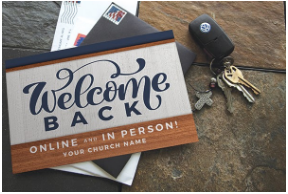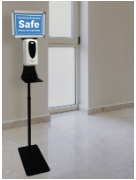Communication is important for a church anytime, but it has become all the more vital during the uncertainties and challenges of the coronavirus pandemic. With limitations on crowd gatherings still in place and cases of COVID-19 on the rise again in many states, worship services continue to look different for most of us—and probably will for the foreseeable future as we move through various phases of gatherings and safety guidelines.
Through it all, we know that the church is people more than place—and that means good, clear communication is key to maintaining relationships, community and spiritual well-being. How and what we communicate matters. In fact, a recent Barna study shows 1in 3 practicing Christians stopped attending church, even online, during this crisis. So keeping the lines of communication open, keeping people engaged and making sure your community knows you are still active is vital.
Whether your congregation and leadership team have had a solid communications plan in place before the pandemic or not, here are some tips on how to communicate about reopening plans and decisions, how to keep staff morale and motivation high, how to maintain community and how to keep reaching out:
How to Maintain Community
1.) Communicate clearly and consistently—with a plan.
 If your church doesn’t have a communications plan and schedule, now is the time to implement one. Following a pre-established plan will not only ensure consistency, but it will provide a framework for your leadership team to follow.
If your church doesn’t have a communications plan and schedule, now is the time to implement one. Following a pre-established plan will not only ensure consistency, but it will provide a framework for your leadership team to follow.
It’s especially critical now that all of your communications are delivered with a consistent voice. Key decisions should be discussed and approved through normal leadership channels, and communications about them should undergo review by several leaders before being distributed. Your communications plan will help clarify the steps and timeline to communicate efficiently and clearly.
Here are some great blog tips on how to strategically create and follow a communications plan:
Creating a Powerful Social Media Strategy for Your Church – Part 1
How to Strategically Communicate Your Church’s Vision, Values, and Culture Online
2.) Engage clearly and often.
So much keeps changing so fast. We all like some level of consistency and predictability, but the pandemic has eroded our sense of “normal.” Now is the time your church needs to hear from you regularly—and probably even more often than before quarantine. You don’t have to have all the answers, but it’s good to let your members know what questions your leadership team is carefully and prayerfully addressing. Again, your communications plan will help you schedule regular messages with frequency.
3.) Use proven channels and add a new one—or two.
 How are people used to hearing from you? What works for reaching your members? Do you already send a weekly email newsletter or monthly print mailing? By all means, keep it up. But now is an excellent time to try new channels for building community, especially when face-to-face gatherings are limited and more difficult.
How are people used to hearing from you? What works for reaching your members? Do you already send a weekly email newsletter or monthly print mailing? By all means, keep it up. But now is an excellent time to try new channels for building community, especially when face-to-face gatherings are limited and more difficult.
Take a survey in your e-newsletter, for example, asking which social media platforms your members use most. Then expand your presence and messaging in a new social platform or two. Keep in mind that your communications plan will help you modify the message points you want to communicate to various lengths and formats for different social and web channels. In other words, you’re not recreating the wheel, just tweaking the message to fit different formats and reach different groups. Check out these blogs for some great tips:
Leveraging Social Media During COVID-19 and Beyond
Creating a Powerful Social Media Strategy for Your Church
4.) Create online community groups.
Just as your members need to hear from top leadership, they also need to connect with each other. This is where you can leverage the power of your small groups and community groups. Use Facebook groups—they can be public or private—where small groups can dialogue with each other. And consider Zoom chats based on neighborhoods or community groups. These could be Bible studies, Q&As with your pastor or leadership team, prayer meetings or simple check ins. Remember, building and maintaining community are the goals, and a little face-time goes a long way.
5.) Don’t forget the power of a note.
 Sending a postcard or letter with an encouraging message and a short handwritten note makes people feel valued and cared for. It can be an especially meaningful tool for older members of your congregation. Check out our postcard options here.
Sending a postcard or letter with an encouraging message and a short handwritten note makes people feel valued and cared for. It can be an especially meaningful tool for older members of your congregation. Check out our postcard options here.
How to Communicate About Reopening Plans
6.) Survey your members.
By now, you’ve probably walked your church through different steps of closures and limited reopenings. It can be a tricky process and one that requires much wisdom and prayer. If you haven’t already, survey your members about their level of concern, comfort and vulnerability. Expect a wide range of perspectives, but you also may be surprised at the various needs you discover. Remember that communication includes listening, and in an unprecedented period for your church, it’s important to give your people a voice in matters that affect the health and safety of all. A survey can also give you an updated snapshot of the age range of your active members—valuable info to consider during the coronavirus pandemic.
7.) Explain your reasoning.
Once you’ve solidified your plans or next steps for reopening, clarify the reasoning. Share key survey results. Identify the steps your leadership team has taken. Cite state and local guidelines you are following. Explain the Scriptural principles underlying your decision-making. You’ll want to communicate these basics as clearly and straightforwardly as possible, perhaps in an email, but it will help to provide more background info and explanation, probably on your website, for those who want more detail. Organizing some Frequently Asked Questions can help your members easily access additional details.
8.) Demonstrate and encourage grace.
The COVID-19 crisis has affected people differently, decimating some lives while only inconveniencing others. Acknowledge that there are different perspectives in your congregation, and call for humility and grace. As the body of Christ, now is the time to tangibly love each other and care for the most vulnerable among us, and the communications from your leadership will set the tone and lead by example.
9.) Make safety guidelines obvious.
 Whatever size gatherings you’re allowed to hold, social distancing and sanitization are paramount. Letting your members and guests know that you’re taking these seriously will help them feel more welcomed and comfortable, as well as encouraging them to comply with your safety protocols. These greeting tools, floor stickers and indoor banners, as well
Whatever size gatherings you’re allowed to hold, social distancing and sanitization are paramount. Letting your members and guests know that you’re taking these seriously will help them feel more welcomed and comfortable, as well as encouraging them to comply with your safety protocols. These greeting tools, floor stickers and indoor banners, as well  as sanitizer stations will help keep safety clear and upbeat.
as sanitizer stations will help keep safety clear and upbeat.
Bottom line…Keep being the Church. Continue to serve members and the community at large. The format and channels may look a little different, but the message of Christ’s love is still the same – don’t stop sharing it!
Next Week in Part 2: How to Keep Staff Morale and Motivation High
